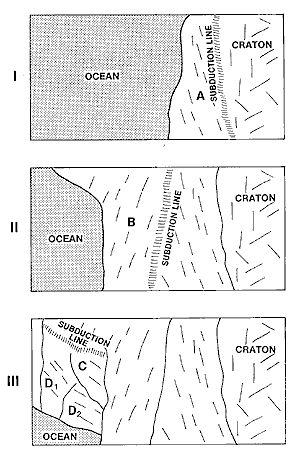| TERRANE | RIDGE DENSITY |
| ELK 1 (Ki) | 5.41 |
| ELK 2 (Ki) | 4.91 |
| YOLLA BOLLY (KJD) | 4.35 |
| ROGUE VALLEY (JRV) | 4.10 |
| DRY BUTTE (JDB) | 3.98 |
| PICKETT PEAK (JC) | 3.46 |
| SIXES RIVER (KJS) | 3.29 |
| SMITH RIVER (JJ) | 3.03 |
| SNOW CAMP (KJM) | 2.70 |
This density value is related to several factors, chief being the "fineness" of the drainage network.
From this map the orientations of ridges (normalized to lengths)
for the entire region can be plotted:
Then, using the above-mentioned program in which the ridges are entered as data points on a digital plotting board that converts them to lines whose average trend directions can be calculated, the orientations of the ridges for any chosen area (such as a terrane or fraction thereof) can be plotted in rose diagrams like those shown above for the Elk and Sixes Rivers terranes. Below is a map in which the most common orientation interval (in 5° units) is drawn in red and the second most common in blue. The prevailing direction for terranes including and east of the Yolla Bolly terrane is NNE, in keeping with the regional plot just shown. But, in the Elk and Sixes River terranes that direction becomes NW.
What might account for this shift in trends? This next (and last)
diagram is a speculation:

In upper panel I, a new terrane smashes into the continental craton along a subduction line of given geometry (including orientation). As the terrane is pushed under (or, it can override the continent), it takes on a fabric whose principal direction(s) is governed by the stress field imposed during emplacement. Now, in panel II, the subduction zone location and geometry have changed and a somewhat different fabric orientation results. In panel III a new subduction zone (bounded by a transform fault [not shown]) adopts a notably shifted orientation and this is passed on to the docking terrane. Then, as erosive processes gradually carve out topographic expressions for the terrane assemblage, streams whose paths tend to be controlled by underlying structural fabric produce valleys and intervening divides that reveal the effects of the stress fields by preferred orientations.
The foregoing report on the writer's research into terrane/terrain interrelations is, as stated previously, incomplete. But, several conclusions are warranted:
- Real differences in geomorphic expression exist among the terranes.
The Klamath terranes are best separated by ridge (and stream)
density differences.
- Variations in hypsometric interval (curve) and related parameters
among terranes may indicate relative resistance to erosion; depends
both on rock types and location within the Klamath "dome".
- Principal directions of ridge orientations seemingly differ in
individual (or clusters of) terranes; this is probably structurally
controlled and could relate to subduction/accretion geometry.
- The principal value of space imagery is that it provides a visual
overview of differences in landforms/topography expression; it
helps to pinpoint areas for quantitative analysis by conventional
morphometric methods.
- Stereo is required for elevation-based morphometry and structural pattern analysis; SPOT-type stereo imagery reduces the illumination bias.
The bottom line: Remote Sensing at present has a limited but positive role in the analysis of landforms by virtue of its excellence in creating synoptic images that highlight regional relationships interpretable visually. This role will increase significantly as high resolution stereo becomes commonplace on sensors flown in space. Ultimately, this will lead to the topological expression of surfaces in a quantitative mode that will prove its worth again, as it has from aerial photography, as a prime approach to geomorphic characterization.
Code 935, Goddard Space Flight Center, NASA
Written by: Nicholas M. Short, Sr. email: nmshort@epix.net
and
Jon Robinson email: Jon.W.Robinson.1@gsfc.nasa.gov
Webmaster: Bill Dickinson Jr. email: rstwebmaster@gsti.com
Web Production: Christiane Robinson, Terri Ho and Nannette Fekete
Updated: 1999.03.15.